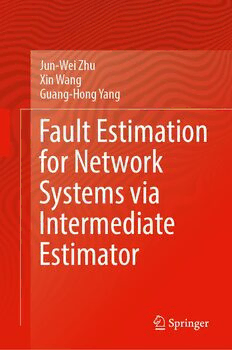Table Of ContentJun-Wei Zhu
Xin Wang
Guang-Hong Yang
Fault Estimation
for Network
Systems via
Intermediate
Estimator
Fault Estimation for Network Systems
via Intermediate Estimator
· ·
Jun-Wei Zhu Xin Wang Guang-Hong Yang
Fault Estimation for Network
Systems via Intermediate
Estimator
Jun-WeiZhu XinWang
InstituteofCyberspaceSecurity HeilongjiangUniversity
ZhejiangUniversityofTechnology Harbin,Heilongjiang,China
Hangzhou,China
Guang-HongYang
CollegeofInformationScience
andEngineering
NortheasternUniversity
Shenyang,China
ISBN 978-981-19-6320-9 ISBN 978-981-19-6321-6 (eBook)
https://doi.org/10.1007/978-981-19-6321-6
©SpringerNatureSingaporePteLtd.2022
Thisworkissubjecttocopyright.AllrightsarereservedbythePublisher,whetherthewholeorpartof
thematerialisconcerned,specificallytherightsoftranslation,reprinting,reuseofillustrations,recitation,
broadcasting,reproductiononmicrofilmsorinanyotherphysicalway,andtransmissionorinformation
storageandretrieval,electronicadaptation,computersoftware,orbysimilarordissimilarmethodology
nowknownorhereafterdeveloped.
Theuseofgeneraldescriptivenames,registerednames,trademarks,servicemarks,etc.inthispublication
doesnotimply,evenintheabsenceofaspecificstatement,thatsuchnamesareexemptfromtherelevant
protectivelawsandregulationsandthereforefreeforgeneraluse.
Thepublisher,theauthors,andtheeditorsaresafetoassumethattheadviceandinformationinthisbook
arebelievedtobetrueandaccurateatthedateofpublication.Neitherthepublishernortheauthorsor
theeditorsgiveawarranty,expressedorimplied,withrespecttothematerialcontainedhereinorforany
errorsoromissionsthatmayhavebeenmade.Thepublisherremainsneutralwithregardtojurisdictional
claimsinpublishedmapsandinstitutionalaffiliations.
ThisSpringerimprintispublishedbytheregisteredcompanySpringerNatureSingaporePteLtd.
The registered company address is: 152 Beach Road, #21-01/04 Gateway East, Singapore 189721,
Singapore
Preface
Becauseasmallfaultintheactualsystemmaycausehugeconsequences,theresearch
onthesafetyandreliabilityofcomplexdynamicsystemshasbecomeanextremely
importanttopic.Inthiscontext,faultestimationtechnologyhasgraduallydeveloped
andbecomeoneofthepopularareasinthecontrolfield.Asweknow,faultdetection
andisolationtechniquesaimtodeterminewhenandwherethefaultsoccur.Unlike
them,faultestimation(FE)techniqueseekstoobtainmorespecificfault’sdynamics
online.Comparedwithfaultdetectionandisolation,FEcanobtainmoreinformation
ofthefault.Generally,FEisachievedbydesigninganobserver.Sofar,avarietyof
different fault observer design methods have appeared, and each method is based
ondifferentideas,sotheyhavedifferentcharacteristics.However,therequirements
of FE are normally stricter, and there are relatively more constraints. Therefore,
there are still a number of challenging issues in FE problems, which greatly limit
theapplicationscopeoftheexistingapproaches.Inthisbook,wemainlystudythe
problemofFEfornetworksystemsincludingnetworkedsinglesystem,multi-agent
system(MAS),andlarge-scaleinterconnectedsystem.Anoveltypeoffaultobserver
calledIntermediateEstimator(IE)isproposedforLipschitziannonlinearsystem,and
aseriesofmodifiedIEsfornetworksystemsarealsopresented.Moreover,thefault
tolerantcontrol(FTC)problemfornetworksystemsisalsostudied.
InChap.1,themotivationandhistoryoftheresearchandanoverviewonrecent
developmentofFEandFTCarepresented.
InChap.2,anewfaultobserverdesignmethod,i.e.,IEisproposedforaclassof
Lipschitziannonlinearsystems.Thisobserverhassignificantlyimprovedthetradi-
tionaladaptiveobserver(AO),itovercomestheimportantconstraintthatthetradi-
tionalAOmustsatisfySPRcondition.Comparedwithothertypesofobservers,this
newtypeoffaultobserverhassomeimportantadvantages,e.g.,(a)itdoesnotneed
tomeettheobservermatchingconditions,(b)theconvergencespeedoftheFEcan
be set and an explicit upper bound of the FE error can be obtained, (c) the norm
upper bounds of the fault itself and the first derivative of the fault do not need to
beknown,(d)thesystemmatrixisalsonotrequiredtosatisfytheuppertriangular
structureconstraint.
v
vi Preface
In Chap. 3, the observer-based fault accommodation (FA) problem for linear
systemswithstateperturbationsandmeasurementerrorsisinvestigated.AnovelIE
isproposedtoestimatethestateandthefaultssimultaneously,wheretheeffectofstate
perturbations and measurement errors is effectively eliminated by fully exploiting
thedesignfreedomofsomespecifiedparameters.Basedontheestimation,anFTC
schemeissynthesized.Itisprovedthatthestatesoftheresultingclosedloopsystem
areuniformlyultimatelyboundedwithanexplicitbound.
In Chap. 4, the FA problem for linear systems with time-varying delay, system
uncertaintiesandexternaldisturbancesisstudied.AnovelIE-basedFTCschemeis
proposed,whereanIEisconstructedtoestimatethestatesandthefaultssimultane-
ously,basedontheestimation,anFTCcompensationschemeisdesignedtomitigate
theeffectsoffaults,systemuncertaintiesandtime-varyingdelay.
In Chap. 5, the robust distributed FE problem is considered for a network of
dynamicalsystemswithexternaldisturbances.Basedonlocaloutputmeasurements
andstateestimatesfromneighbors,adistributedIEisconstructedforeachnode.By
spectraldecompositionoftheLaplacianandproperscalingofthefaultsandthedistur-
bances,aspecially-structuredglobalerrorsystemcanbecreated.Itisprovedthatthe
statesoftheglobalerrorsystemareuniformlyultimatelyboundedwithanexplicit
error bound. The robustness of the global error system can be ensured by directly
adjusting the design parameters of the IEs, without introducing any performance
specification.
InChap.6,westudytheobserver-basedfaulttoleranttrackingcontrolproblemfor
linearMASswithmultiplefaultsandmismatcheddisturbances.Anoveldistributed
IE-basedfaulttoleranttrackingprotocolispresented.Theleader’sinputisnonzero
andunavailabletothefollowers.Byapplyingaprojectiontechnique,themismatched
disturbancesaredividedintomatchedandunmatchedcomponents.Foreachnode,
atrackingerrorsystemisestablished,forwhichanIEdrivenbytherelativeoutput
measurementsisconstructedtoestimatethesensorfaultsandacombinedsignalof
theleader’sinput,processfaults,andmatcheddisturbancecomponent.Basedonthe
estimation,afaulttoleranttrackingprotocolisdesignedtoeliminatetheeffectsof
thecombined signal.Besides,theeffectofunmatched disturbancecomponent can
beattenuatedbydirectlyadjustingsomespecifiedparameters.
In Chap. 7, the cooperative tracking control problem for MASs with unknown
externaldisturbancesunderadirectedgraphisstudied.Theleader’sinputisnonzero
andunavailabletothefollowers.Basedontherelativeoutputmeasurementsofneigh-
boring agents, a novel observer-based cooperative tracking protocol is presented,
whereagroupofIEsareconstructedtoestimatethetrackingerrorsandthecombined
signalofthedisturbancesandtheleader’sinputsimultaneously,thendecentralized
trackingprotocolsaredesignedbasedontheobtainedestimates.
InChap.8,weproposeanimprovedobserver-basedfault-toleranttrackingcontrol
approachforindustrialMASs.Firstly,agroupofnewdistributedIEsarepresented,
where the design structure is modified to enhance the feasibility of the estimation
scheme. It is shown that the both of the nominal distributed IE and the traditional
extendedstateobserver(ESO)arespecialcasesoftheproposedestimator.Secondly,
theestimationperformancecanbeimprovedsignificantlyviaanonlinereinforcement
Preface vii
learningestimationstrategy,whosecoreisanadaptive switchingmechanism inte-
gratedwithafunctionblockofsourcefaultmodelocalization.Benefitingfromsatis-
factory estimation results, good fault-tolerant tracking control performance can be
guaranteeddespiteofmultiplefaultsanddisturbances.Theapplicationtoanetworked
multi-axismotioncontrolsystemdemonstratestheeffectivenessandsuperiorityof
theproposedmethod.
In Chap. 9, the fault reconstruction problem of mobile robots is studied. To be
specific,anovelIEisproposedtoreconstructthefaults,wheretheestimationperfor-
manceisguaranteedinthesenseofdrivingtheestimationerrorstoasmallprescribed
energyboundviaatwo-dimensionalgain-regulationmechanism.Itisshownthatthe
proposedestimatorismoreaccuratethantheexistingESOandnominalIE.
InChap.10,weconsiderthemultipleattackreconstructionproblemforCPSs.A
newprojectedintermediateestimatorisproposed,wherethecomputationcomplexity
problem is solved by reducing the number of loop iterations significantly via
enhancingthedesignsofloopiteration,terminationconditionandparameterselec-
tionstrategy,withoutsacrificingtheattackreconstructionperformance.Compared
with traditional IEs, the dependence of linear matrix inequality technique is
completelyremoved,besides,theintrinsicheavyovershootingproblemintransient
periodiseffectivelyalleviated.
Finally,conclusionsandfutureresearchdirectionsarepresentedinChap.11.
Hangzhou,China Jun-WeiZhu
XinWang
Guang-HongYang
Acknowledgements
ThisworkisdedicatedtomywifeXiao-LingZhouandmyPh.D.studentCao-Yuan
Gu. The authors would like to express especial thanks to Prof. Steven X. Ding,
oftheInstituteforAutomaticControlandComplexSystems(AKS),Universityof
Duisburg-Essen,47057Duisburg,Germanyfortheirvaluablecommentsandencour-
agementontheresearchwork.Meanwhile,theauthorswouldliketoacknowledge
the support of research grants, including National Natural Science Foundation of
China (61803334, 61822311, 61703148, 61673351), Zhejiang Provincial Natural
ScienceFoundationofChina(LZ21F030004,LQ18F030012),theStateScholarship
FundofChinaScholarshipCouncil(201908330040),NSFC-ZhejiangJointFundfor
theIntegrationofIndustrializationandInformatization(U1709213).
ix
Contents
1 Introduction .................................................. 1
1.1 Background ............................................. 1
1.2 BasicConceptsinFaultDiagnosis .......................... 2
1.3 FEMethodandResearchStatus ............................ 3
1.4 ResearchStatusforFTC .................................. 5
1.5 BookOutline ............................................ 7
2 IEforLipschitzianNonlinearSystems .......................... 11
2.1 Introduction ............................................. 11
2.2 ProblemStatementandPreliminaries ........................ 12
2.3 DesignoftheIE .......................................... 13
2.3.1 TheIEDesignforNonlinearSystemswithSingle
Faults ........................................... 13
2.3.2 Extension of IE for Nonlinear Systems
withMultipleFaults ............................... 17
2.4 SimulationExample ...................................... 20
2.4.1 ExampleI ....................................... 20
2.4.2 ExampleII ....................................... 21
2.5 Conclusion .............................................. 25
3 IEforUncertainSystems ...................................... 27
3.1 Introduction ............................................. 27
3.2 PreliminariesandProblemStatement ........................ 28
3.3 TheDesignoftheIE-BasedFAStrategy ..................... 29
3.4 Example ................................................ 34
3.4.1 Example1 ....................................... 34
3.4.2 Example2 ....................................... 36
3.5 Conclusion .............................................. 40
xi
xii Contents
4 IEforTime-VaryingDelaySystems ............................. 43
4.1 Introduction ............................................. 43
4.2 ProblemStatementandPreliminaries ........................ 44
4.3 IE-BasedFTCScheme .................................... 45
4.4 SimulationExample ...................................... 50
4.5 Conclusion .............................................. 53
5 DistributedIEforComplexNetworks ........................... 55
5.1 Introduction ............................................. 55
5.2 PreliminariesandProblemStatement ........................ 56
5.2.1 BasicGraphTheory ............................... 56
5.2.2 ProblemStatement ................................ 56
5.3 TheDesignoftheDistributedIEs ........................... 57
5.4 SimulationExample ...................................... 64
5.4.1 ExampleI ....................................... 64
5.4.2 ExampleII ....................................... 69
5.5 Conclusion .............................................. 75
6 DistributedIEforMASswithUndirectedGraph ................. 77
6.1 Introduction ............................................. 77
6.2 PreliminariesandProblemStatement ........................ 78
6.2.1 BasicGraphTheory ............................... 78
6.2.2 ProblemStatement ................................ 78
6.3 TheDesignoftheDistributedIEBasedFaultTolerant
TrackingProtocol ........................................ 80
6.4 SimulationExample ...................................... 87
6.5 Conclusion .............................................. 95
7 DistributedIEforMASswithDirectedGraph ................... 97
7.1 Introduction ............................................. 97
7.2 PreliminariesandProblemStatement ........................ 98
7.3 TheDesignoftheIE-basedTrackingProtocol ................ 99
7.4 SimulationExample ...................................... 105
7.5 Conclusion .............................................. 109
8 IntelligentIEforMASs ........................................ 111
8.1 Introduction ............................................. 111
8.2 PreliminariesandProblemStatement ........................ 112
8.2.1 GraphTheory .................................... 112
8.2.2 ProblemStatement ................................ 113
8.3 MainResults ............................................ 114
8.3.1 A Novel Observer-based CFTTC Protocol
withAdaptiveSwitchingMechanism ................ 114
8.3.2 StabilityAnalysis ................................. 117
8.3.3 CFTTCwithOnlineReinforcementLearning
EstimationStrategy ............................... 121

